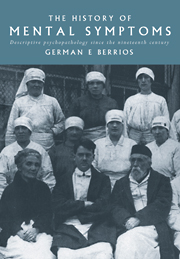Book contents
- Frontmatter
- Contents
- PREFACE
- ACKNOWLEDGEMENTS
- INTRODUCTION
- PART I The object of inquiry
- PART II Cognition and consciousness
- CHAPTER 3 Disorders of perception
- CHAPTER 4 Thought disorder
- CHAPTER 5 Delusions
- CHAPTER 6 Obsessions and compulsions
- CHAPTER 7 Mental Retardation
- CHAPTER 8 Cognitive impairment
- CHAPTER 9 Memory and its disorders
- CHAPTER 10 Consciousness and its disorders
- PART III Mood and emotions
- PART IV Volition and action
- PART V Miscellany
- REFERENCES
- NAME INDEX
- SUBJECT INDEX
CHAPTER 6 - Obsessions and compulsions
from PART II - Cognition and consciousness
Published online by Cambridge University Press: 08 January 2010
- Frontmatter
- Contents
- PREFACE
- ACKNOWLEDGEMENTS
- INTRODUCTION
- PART I The object of inquiry
- PART II Cognition and consciousness
- CHAPTER 3 Disorders of perception
- CHAPTER 4 Thought disorder
- CHAPTER 5 Delusions
- CHAPTER 6 Obsessions and compulsions
- CHAPTER 7 Mental Retardation
- CHAPTER 8 Cognitive impairment
- CHAPTER 9 Memory and its disorders
- CHAPTER 10 Consciousness and its disorders
- PART III Mood and emotions
- PART IV Volition and action
- PART V Miscellany
- REFERENCES
- NAME INDEX
- SUBJECT INDEX
Summary
The terms obsession and compulsion name interloping and iterative thoughts and actions of a type and severity that may fracture behaviour. The condition is accompanied by feelings of distress, and declarations of resistance. Insight is assumed to be present but it may be belied by bizarre checking behaviour. Since last century, major works of scholarship on this condition have appeared. But obsession-like behaviours can be found mentioned in the literature of the ages, often under social or religious labels; and the question of whether such phenomena are neurobiologically equivalent to what is now called obsessive-compulsive disorder is tantalising. The medical concepts built into this diagnosis were tooled in Europe during the second half of the nineteenth century. This chapter deals with the historical process whereby such concepts and behaviours were brought together and transformed into a disease.
Obsession before 1800
In the Anatomy of Melancholy, Robert Burton reported an individual ‘who dared not go over a bridge, come near a pool, rock, steep hill, lie in a chamber where cross beams were, for fear he be tempted to hang, drown or precipitate himself. In a silent auditorium as at a sermon, he [was] afraid he shall speak aloud at unawares, something indecent, unfit to be said …’ Bishop Moore of Norwich referred to subjects overwhelmed by ‘naughty and sometimes blasphemous thoughts’ which ‘start in their minds while they are exercised in the Worship of God’.
- Type
- Chapter
- Information
- The History of Mental SymptomsDescriptive Psychopathology since the Nineteenth Century, pp. 140 - 156Publisher: Cambridge University PressPrint publication year: 1996



